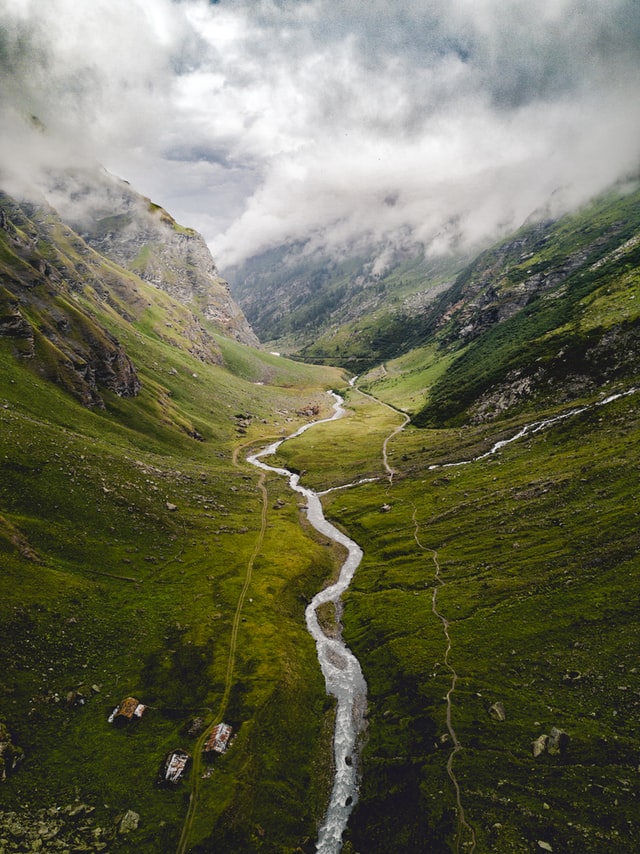This article discusses the concept of erosion- how the rocks wear away over time and how this effects water flow.
This essay compares and contrasts erosion in different forms of media, citing their different exponents.
The author talks about sedimentation, the shape of a riverbed as well as
it’s obvious purpose to store water runoff from rain/flooding events,
its creation as well as what it does to erosion issues in rivers.
In conclusion, the essay outlines ways that we can deal with this issue to preserve our rivers for future generations.
Wendy Douglas’ essay
is based on her personal experiences working on the Mississippi River in St. Louis as a water resources engineer.
At this time the river was eroding sideways and slightly downstream,
which is not good for boat traffic or recreational use.
She explains how sedimentation was formed over time and how excavation works to fix it.
She also talks about the shape of a riverbed and the purpose for the creation of one.
She concludes with some facts about erosion and
how it effects water flow and boat traffic on both large rivers and small streams.
The author makes a lot of good points throughout this article, some of them obvious, many of them not.
Throughout her article it was very clear to see that she wanted us to be aware that erosion is not always just straight downstream,
but can be from side to side as well. She used many great examples to try and prove this as
she explains how sedimentation formed as well as what it does in rivers.
She also makes us aware of how to fix erosion issues, as well as being able to maintain the longevity of the river so that it does not erode sideways at any point in time.
The authors’ tone throughout her article was positive and she seemed happy to explain how to work on erosion issues in rivers.
Also, seeing just how much she loves being a water resources engineer, and how passionate she is about what she does.
I liked this article very much, and found it really informative as well as interesting.
It was nice to get a first hand account of this issue, especially from someone who is working so close to it.
She did a great job of explaining sedimentation,
the shape of the riverbed and its purpose, as well as its relation to water flow and erosion that occurs on rivers.
This was not covered in great detail here as it was with riverbeds, boats and water flow.
I think it would have been very interesting to learn about how little streams erode, and the reason for it.
I also found this article very interesting because I have always wanted to find out if there was any truth to the story of erosion from side to side.
The Dangers of Water Pollution
In this article, Wendy Douglas makes a thorough and informative case against the claims
that erosion is always from side-to-side or even uphill as seen when dams are built.
A few specific examples were used in her highly persuasive argument. She pointed out that erosion can be destructive for boat traffic,
that sedimentation is in place for a reason and that excavation does fix issues with erosion occurring downstream.
I enjoyed reading this article and found it to be very interesting.
I feel that Douglas did a great job of explaining the erosion sources and possible solutions that can be done for preventing future erosion. where is erosion concentrated along a meandering stream?
The author made an excellent job of reporting on her personal experiences concerning erosion in the Mississippi River Basin of St. Louis, Missouri.
I particularly enjoyed her description of how the river bed was formed by sedimentation over time,
as well as what it does for water flow and boat traffic.
I also found it very interesting
to learn about how sediments collected were transported down river,
along with the shape of a river bed, which is obviously formed by sedimentation over time.
I thought it was really nice that the author provided some great examples of how this process works by using the Mississippi River.
The last part of her article I found funny, as she discussed how erosion is more important than most people think,
and that a small amount can be very damaging to entire regions.
I think that Douglas did a fantastic job of explaining erosion and its relation to boat traffic and water flow in the Mississippi River Basin.
She also discusses sedimentation being formed over time and what it does for water flow.
I thought this was very interesting because it explained the process that sedimentation went through and what sedimentation does for water flow in rivers.
This article discusses the concept of erosion- how the rocks wear away over time and how this effects water flow.
This essay compares and contrasts erosion in different forms of media, citing their different exponents.
The author talks about sedimentation, the shape of a riverbed as well as it’s obvious purpose to store water runoff from rain/flooding events,
its creation as well as what it does to erosion issues in rivers.
In conclusion, the essay outlines ways that we can deal with this issue to preserve our rivers for future generations.
Wendy Douglas’ essay
is based on her personal experiences working on the Mississippi River in St. Louis as a water resources engineer.
At this time the river was eroding sideways and slightly downstream, which is not good for boat traffic or recreational use.
She explains how sedimentation was formed over time and how excavation works to fix it.
She also talks about the shape of a riverbed and the purpose for the creation of one.
She concludes with some facts about erosion and how it effects water flow and boat traffic on both large rivers and small streams.
The author makes a lot of good points throughout this article, some of them obvious, many of them not.
Throughout her article it was very clear to see that she wanted us to be aware that erosion is not always just straight downstream,
but can be from side to side as well and used many great examples to try and prove this as
she explains how sedimentation formed as well as what it does in rivers.
She also makes us aware of how to fix erosion issues, as well as being able to maintain the longevity of the river so that it does not erode sideways at any point in time.
The authors’ tone throughout her article was positive and she seemed happy to explain how to work on erosion issues in rivers.
Also, seeing just how much she loves being a water resources engineer, and how passionate she is about what she does.
I liked this article very much, and found it really informative as well as interesting.
It was nice to get a first hand account of this issue, especially from someone who is working so close to it.
She did a great job of explaining sedimentation,
the shape of the riverbed and its purpose, as well as its relation to water flow and erosion that occurs on rivers.
This was not covered in great detail here as it was with riverbeds, boats and water flow.
I think it would have been very interesting to learn about how little streams erode, and the reason for it.
I also found this article very interesting because I have always wanted to find out if there was any truth to the story of erosion from side to side.
The Dangers of Water Pollution
In this article, Wendy Douglas makes a thorough and informative case against the claims
that erosion is always from side-to-side or even uphill as seen when dams are built.
A few specific examples were used in her highly persuasive argument. She pointed out that erosion can be destructive for boat traffic,
that sedimentation is in place for a reason and that excavation does fix issues with erosion occurring downstream.
I enjoyed reading this article and found it to be very interesting.
I feel that Douglas did a great job of explaining the erosion sources and
possible solutions that can be done for preventing future erosion. where is erosion concentrated along a meandering stream?
The author made an excellent job of reporting on her personal experiences concerning erosion in the Mississippi River Basin of St. Louis, Missouri.
I particularly enjoyed her description of how the river bed was formed by sedimentation over time,
as well as what it does for water flow and boat traffic.
I also found it very interesting
to learn about how sediments collected were transported down river,
along with the shape of a river bed, which is obviously formed by sedimentation over time.
I thought it was really nice that the author provided some great examples of how this process works by using the Mississippi River.
The last part of her article I found funny,
as she discussed how erosion is more important than most people think,
and that a small amount can be very damaging to entire regions.
I think that Douglas did a fantastic job of explaining erosion and
its relation to boat traffic and water flow in the Mississippi River Basin.
She also discusses sedimentation being formed over time and what it does for water flow.
I thought this was very interesting because it explained the process
that sedimentation went through and what sedimentation does for water flow in rivers.











